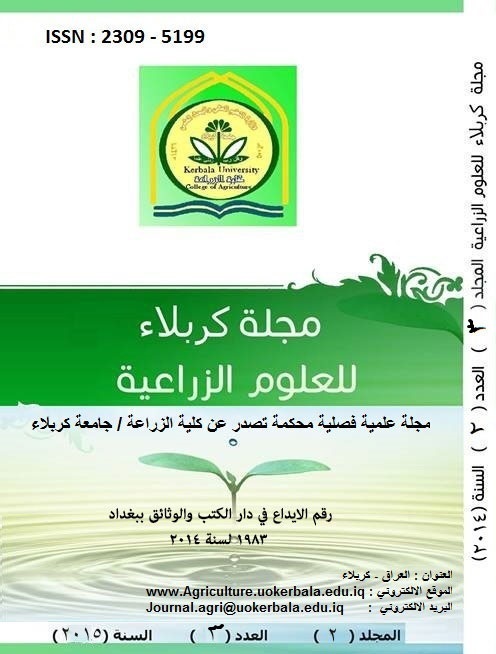The effect of stratification and treatment with GA3 in some vegetative and root growth characters of apricot (Prunus armeniaca L.)
DOI:
https://doi.org/10.59658/jkas.v2i3.437Keywords:
stratification , GA3 , apricot seedsAbstract
The experiment was conducted at the college of Agriculture / University of Karbala for the season 2009-2010 on the local apricot seeds to show the effect of periods stratification as well as treatment with Gibberellic acid on seed germination and growth where they were setting seed intervals (0, 30.45 and 60 day) at temperature (5 ± 1 ºC) after that it has been treated with concentrations (0,50 and 100 mg.ltr -1) of Gibberellic acid
The results of the statistical analysis showed that the stratification period (60 days) was the best in the average number of( leaves , root length and weight of the wet roots) reaching (18.10, 16.79 cm and 0.562 g) sequentially while the transaction led Gibberellic acid concentration (100 mg.ltr -1) to give the highest in the Each of wet leaves weight , root length and number of leaves as it was (1.747 g, 16.40 cm and 18.44) sequentially while given treatment Gibberellic acid concentration (50 mg.ltr -1) the highest rate in (dry leaves weight, number of roots, the weight of the roots wet and dry) it was (0.588 g, 38.50, 0.578 g and 0.219 g) sequentially.
It was not significant the interaction between the periods stratification and treatment with Gibberellic acid concentrations in most of the studied characters except average number of leaves in the transaction (60 day concentration of 100 mg.ltr -1), which was significantly outperformed the rest of the transactions giving it the highest rate of 19.58.
Downloads
Published
How to Cite
Issue
Section
License
Copyright (c) 2015 Copyright (c) 2024 is the Author's article. Published by the Journal of Kerbala for Agricultural Sciences under a CC BY 4.0 license

This work is licensed under a Creative Commons Attribution 4.0 International License.
Licensing Terms
All articles are published under a Creative Commons License and will be directed to the Creative Commons Attribution 4.0 International License (CC BY 4.0) That permits use, distribution, and reproduction in any medium, provided the original work is properly cited. This license also allows the work to be used for commercial purposes.
Use by both non-commercial and commercial users
This content is licensed under a Creative Commons Attribution 4.0 International (CC BY 4.0) license, permitting use by both non-commercial and commercial users. Individual users may access, download, copy, display, and redistribute the articles to colleagues, as well as adapt, translate, and text- and data-mine the content, subject to the following conditions:
- The author's moral rights, including the right of attribution and the right to protect their work from derogatory treatment, are respected.
- Where content in the article is identified as belonging to a third party, users must ensure that any reuse complies with the copyright policies of the owner of that content.
- If the article content is reused for research or educational purposes, users should maintain a link to the appropriate bibliographic citation, including the DOI and a link to the published version on the journal's website.

